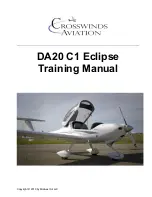
16
speed of rotation and descent with small changes of interior and exterior brake, and
more or less weight shift. It is possible to achieve descent rates of 10-15m/s or more in
this manoeuvre.
It is dangerous to induce spiral dives close to the ground due to the extreme centrifugal
forces which can cause fainting and, in some cases, blackouts or blurred vision..If you are
at all susceptible to any of these conditions, or are feeling at all unwell for any reason,
then you should not induce a spiral dive for this reason.
The exit from this manoeuvre should be performed gradually and progressively, finishing
in a nice controlled gentle turn to re-stabilise the wing. To do this, the pilot has to gra-
dually ease off the inside brake, and reduce weight shift, then gently apply a little out-
side brake to ease the glider out of the spiral. The pilot must be very careful not to exit
a spiral (especially if well developed) too briskly, as this could result in a steep climb out
(with the wing far behind the pilot and in a very vulnerable position, with little internal
pressure, no airspeed and prone to collapses) followed by a sharp dive which may need
damping to prevent a collapse.
It is NOT recommended to induce a spiral dive at the same time as applying any thrust
or power from the engine, as this could result in instability.
-- b-line stall
To induce a ‘B-line” stall, first take hold of both ‘B’ risers (left and right) one
in each hand (left and right respectively) FIRMLY at the maillons. Then, pull the
B-risers down together to approximately the level of the karabiners, BEING
VERY CAREFUL TO DO THIS SYMMETRICALLY so as to not induce a spin. This will
“B-stall” the glider, by deforming the aerofoil section of the wing in such a way
as to stop the airflow going over it as normal, effectively ‘breaking’ the aero-
foil effect. If done correctly, the glider will now enter into a “B-line stall”,
which is a kind of “parachutal” stall, stopping the glider flying and rendering
one’s trajectory effectively straight down through the air (BUT DRIFTING WITH
THE WIND). Once in the “B-line” stall one can control the descent rate to a
degree by pulling down more or less on the B-risers and it is possible (in still
air) to achieve descent rates from 5-11 m/s. BE CAREFUL, AS PULLING DOWN
TOO FAR ON THE B-LINES CAN CAUSE THE GLIDER TO BECOME UNSTABLE, SO
THIS SHOULD BE AVOIDED.
To exit from the B-line stall correctly, and minimise the chance of any instabi-
lity, the pilot should keep a firm hold of the B-risers and raise them until there
remains 10cm of travel of the B-risers and then release them completely,
taking care to do this SIMULTANEOUSLY. If the B-line is entered, or released,
asymmetrically, it is possible to enter a spin, and so this should always be avoi-
ded. Once the B-risers have been released in the correct manner the glider will
return to normal flight spontaneously with a small dive as it regains “healthy”
airspeed.
Summary of Contents for Kinetik 25
Page 1: ...K I N E T I K m a n u a l...
Page 2: ......
Page 3: ...3 Windtech w w w w i n d t e c h e s K I N E T I K 2 5 2 7 3 0 flight manual...
Page 18: ...18...
Page 20: ...20...
Page 24: ...24 flight log size date site duration flight details K K I I N N E E T T I I K K...
Page 25: ......








































